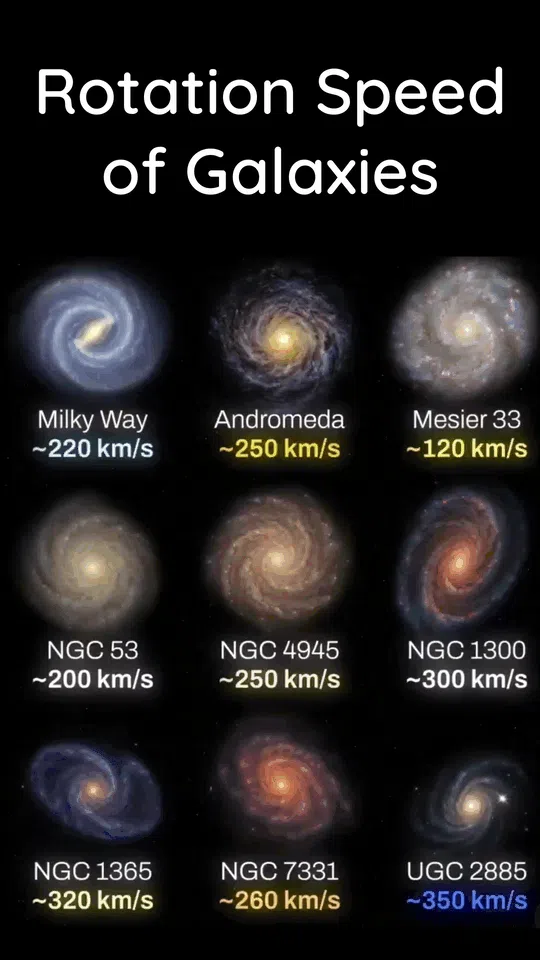Unraveling the Mysteries of Galaxy Rotation: It's Not as Simple as it Looks!
Have you ever seen those mesmerizing animations of galaxies spinning gracefully, perhaps labeled with a simple "rotation speed" in kilometers per second or degrees per second? While visually appealing, these depictions often oversimplify one of the most perplexing and fascinating aspects of galactic dynamics. As many keen observers and astronomers can attest, describing the "rotation speed" of an entire galaxy like a rigid body is fundamentally misleading. So, how do galaxies really rotate?
The Flawed Concept of a Single "Rotation Speed"
Unlike a spinning top or a compact disc, a galaxy is not a solid object. It's a vast collection of billions of stars, gas, dust, and dark matter, all orbiting a common gravitational center. Each star, just like planets in a solar system, follows its own independent orbit. This means that stars closer to the galactic center will have different orbital periods and linear velocities than those further out. Simply assigning a single rotation speed to a whole galaxy, whether in km/s or degrees/second, ignores this intricate ballet of individual celestial bodies.
Imagine trying to describe the "speed" of a flock of birds – it's more about the individual paths and speeds of each bird relative to the flock's overall motion.
 An idealized animation of galaxy rotation, which simplifies the complex realities of stellar orbits.
An idealized animation of galaxy rotation, which simplifies the complex realities of stellar orbits.
The Curious Case of the Flat Rotation Curve
For decades, astronomers have studied galactic rotation by measuring the velocities of stars and gas at various distances from the galactic center. Based on Newtonian physics and the visible mass of a galaxy, one would expect stars further out to orbit progressively slower, similar to how outer planets orbit the Sun at slower speeds. This predicted decrease in speed with increasing distance is known as a "Keplerian fall-off."
However, what observations consistently revealed was something entirely unexpected: the rotation curve of spiral galaxies, which plots orbital velocity against distance from the center, doesn't fall off as predicted. Instead, it remains remarkably flat even at vast distances from the visible galactic core. This means that stars and gas far from the center are orbiting at roughly the same linear speed as those much closer in.
The Dark Matter Hypothesis
This puzzling observation posed a significant challenge to our understanding of gravity and galactic structure. If the visible matter (stars, gas, dust) were all that existed, the outer parts of galaxies would be spinning so fast that they should simply fly apart. To explain the observed flat rotation curves, scientists proposed the existence of an unseen, non-luminous form of matter – dark matter.
Dark matter is hypothesized to form a vast, spherical halo extending far beyond the visible disc of a galaxy. Its gravitational influence provides the additional mass needed to keep the outer stars orbiting at their observed speeds, preventing the galaxy from tearing itself apart. The flat rotation curve is, in fact, one of the strongest pieces of evidence for the existence of dark matter, a mysterious component believed to make up about 27% of the universe's mass-energy content.
Understanding Spiral Arms: Density Waves, Not Solid Structures
Another common misconception is that the beautiful spiral arms of galaxies rotate like rigid spokes. In reality, spiral arms are better understood as density waves. Imagine a traffic jam on a highway: cars enter the jam, slow down, move through it, and then speed up as they exit. The cars are constantly moving, but the 'jam' itself, the region of higher density, persists in roughly the same location.
Similarly, stars and gas move through the spiral arms, temporarily slowing down and increasing in density as they pass through these regions. The arms themselves are not static structures rotating uniformly, but rather areas where the density of stars and gas is temporarily higher, often triggering new star formation.
The Ongoing Quest
The rotation of galaxies is a testament to the complex interplay of gravity, matter, and cosmic evolution. Far from being simple spinning objects, galaxies are dynamic systems where individual stars follow intricate paths, governed by the combined gravitational pull of visible matter and the elusive dark matter. The study of galactic rotation continues to be a vibrant field, pushing the boundaries of our understanding of the universe and its most mysterious components.




